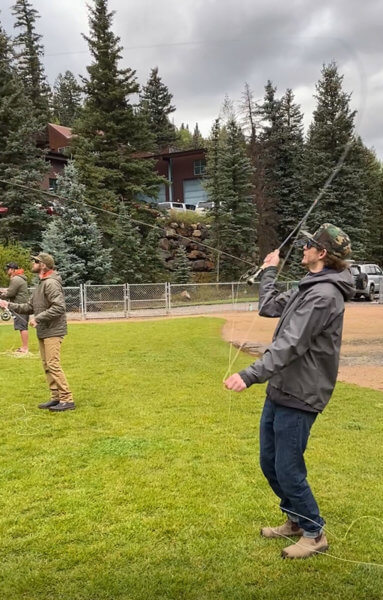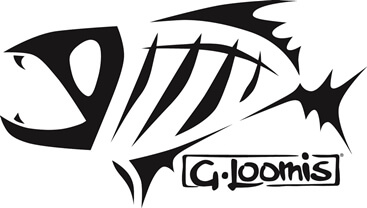Head to Head: Wave v. Maverick v. IMX-Pro V2S
The introduction of the G.Loomis IMX-Pro V2S prompts a comparison to the Sage Maverick and Scott Wave, proven performers in the mid-priced saltwater category. With great interest, we spooled up lines that we felt most suitable to each rod class and cast them side-by-side. Four casters worked through the lineup and contributed their findings to this article: Parker Thompson, Jack Healy, Richard Post and John Duncan. The article is presented by John Duncan but includes input from all four Telluride Angler staff on each rod comparison. Duncan paraphrases much of the feedback but has attempted to present rod descriptions using the words of the casters.
Lines cast on each rod/line weight

9’ 7-weights: Rio Elite Bonefish, Rio Elite Flats Pro
9’ 8-weights: Rio Elite Bonefish, Rio Redfish
9’ 9-weights: Rio Elite Permit, Rio Elite Flats Pro
9’ 10-weights: Rio Elite Permit, Rio Elite Flats Pro
9’ 11-weights: Rio Elite Tarpon, Rio Elite Flats Pro
9’ 12-weights: Rio Elite Tarpon, Rio Elite GT
Generalizations
- Wave rods are lighter and easier to cast.
- The Mavericks are heavier, potentially stronger for the fight and lean toward being overbuilt for their purposes, especially in the lighter line weights. Time will prove if they are more durable. This difference highlights a fundamental design strategy of Scott and Sage saltwater fly rods, born out in other rod comparisons over the decades. Loomis IMX-Pro V2S are “trouty” in the 6 and 7-weights, but beefy and stiff in line weights 8-12.
- Sage and G.Loomis components are heavier duty. In particular, the guide sets and reel seats are more substantial. This will be a confidence builder for some anglers. The relatively lightweight Scott components may not prove a liability, but for some anglers, this may tip the choice in the higher line weights.
- Scott grips are smaller and more contoured, a higher quality and more thoughtful grip choice. We prefer them in all line weights, but especially #6-9.
- As a group of casters, we generally preferred the Scotts in line weight 7-9, but the Sage and Loomis models in 10-12 where fish fighting and raw muscle are higher priorities than sweetness and casting ease. Below, we attempt to describe each rod objectively so you may determine which suits your fishing scenarios and casting style. In some cases, a rod becomes preferred only with a specific line pairing.
- We are impressed with both the Wave and Maverick series. Anglers seeking a mid-priced saltwater rod that fishes above its price will no doubt smile years later when recalling their choice. Good job, Scott, Loomis and Sage. These are awesome rods.
Model Comparisons
Wave 906-4 vs Maverick 690-4 vs IMX Pro V2S 690-4
We cast these rods with a Rio Elite Bonefish line, which seemed to bring out their best characteristics. All three swing nice and light with pleasing crispness and stability. The Maverick feels a bit more “trouty,” with a smoothness at short distance reminiscent of our favorite freshwater rods. The Scott is a little more programmed to throw tight loops with a small bonefish fly. In this way, the 6 and 7-weight models in each series are opposite from each other. For freshwater/saltwater crossover, we would prefer the Maverick 690-4 or the Scott 907-4. The Maverick 690-4 would be our choice for trout streamers and bass fishing. The Scott throws tighter loops with a bonefish taper, but the Maverick will handle a wider variety of freshwater and saltwater fly lines. The Loomis IMX-Pro V2S falls smack in between, a light and nimble saltwater caster for the angler looking to fish a trout-style rod in the salt.
All three of these 6-weights cast natural loops right out of hand and are well-tuned to the purposes of the 6-weight line class. The Scott finishes the cast with a bit more authority but also requires a little more finesse in the casting stroke. Like many Scott rods, it is more responsive to the nuances of the caster’s input than the Sage or Loomis. We all felt that the Sage grip is a little big and chunky for a 6-weight, which creates a slight feeling of detachment from the rod. The Scott grip is well contoured and appropriately scaled, which contributes to the rod’s feel. The Loomis feels great in hand, too, and swings with pleasing familiarity, but will require calm weather to fish all day. The Scott has an edge over the Sage and Loomis for knifing through the wind with tight loops.
Wave 907-4 vs Maverick 790-4 vs IMX-Pro V2S 790-4
In the Scott and Sage, we have two excellent fly rods that classically represent the ethos of those companies and are clearly intended for the saltwater angler. We’re going to talk mostly about these rods, because the Loomis IMX-Pro V2S 790-4 possesses a character more suited to freshwater fishing with heavy trout and bass techniques. The butt section of this rod is powerful and stable, so it casts heavy-headed lines with confidence, but it requires a much slower casting cadence and doesn’t throw the tight loops required for flats fishing. Choose the Loomis if you seek a strong freshwater rod that may occasionally be fished in the salt, but not as a dedicated saltwater 7-weight.
The Maverick 790-4 is one of the best rods in its series. It has a short flex window near the top of the rod, so it throws laser loops but requires a short, crisp, powerful stroke from the caster. You can whack this rod in the wind and it’s hard to overpower. The Maverick derives its power from stiffness in the butt and mid sections, the Scott from springiness and loop shape. It flexes more evenly and intuitively for the first-time caster. It is more line tolerant and offers better loop control, but can be overpowered more easily than the Sage. The Scott is more versatile and will make a better crossover rod to freshwater. The Sage is a more pure saltwater stick, designed with classic “tip action” for casting in the wind. All of our casters liked both rods and had something interesting to say about their distinctions:
Parker Thompson: “Both rods are good at all distances. The Maverick wants to throw daggers while the Scott can be manipulated to produce different loop shapes.”
Jack Healy: “Some rods have that magic from the first cast, like the Scott. Others, you have to work into, like the Sage. They do the same things, but in different ways. Choosing between these rods gets down to casting style.”
John Duncan: The Sage is a nail driver. The Scott will be appreciated by advanced anglers who vary their casting stroke.
Rich: “The Maverick 790-4 is a great rod, really impressive, a serious saltwater stick all the way. It throws those V-shape loops no matter what. The Scott casts a shade heavier and has more load in the lower 1/3 of the rod.”
Wave 908-4 vs Maverick 890-4 vs IMX-Pro V2S 890-4
In terms of stiffness and action, the Scott and Sage are really distinct with the Loomis falling right in the middle. We cast them all with a Rio Elite Bonefish and a Rio Redfish taper, the latter of which is one full line class heavy in the head. The Scott feels lighter and casts lighter. It is awesome with the Bonefish taper, airy and nimble, casting with huge line speed and wonderful accuracy. It is almost as capable with the Redfish taper, but you can feel that head weight pulling the tip around just a touch. From a fishing standpoint, it will handle either fly line and their quarry. From a casting standpoint, it is truly special with a Bonefish taper but just decent with the Redfish line.
The Maverick 890-4 is a much heavier rod that excels with the heavy-headed Redfish taper, but earns much lower marks with a Bonefish line. Until you overline this rod, it casts medium-tight loops with little feel and unremarkable line speed. With a Redfish line, however, it becomes a truly outstanding “8.5-weight.” In fact, two of our casters thought that the Maverick with a Redfish line was the best rod/line combo that we compared all day. The Maverick will also cast and fish great with other heavy lines, including the Rio Elite Flats Pro and SA Amplitude Grand Slam, but it requires a heavy-headed line to come to life.
The IMX-Pro V2S 890-4 generates incredible line speed with an SA Amplitude Bonefish line (we cast it with both the SA and Rio Bonefish tapers, loved them both). The rod possesses more bottom end strength for playing heavy fish than the Scott, but the Sage is still a head above either the Scott or Loomis in this department. To be clear, all three rods have adequate power for their line weights and purposes. The Sage seems overbuilt for an 8-weight, which will be desirable to some anglers, but certainly not everyone. The fishability of this rod is outstanding, but the Scott offers considerably more feel and casts tighter loops while the Sage fishes more like a 9-weight. If you have fished other Loomis saltwater rods and seek a mid-priced stick with similar characteristics, choose this rod and don’t look back.
Wave 909-4 vs Maverick 990-4 vs IMX-Pro V2S 990-4

All of our casters noted that the Scott is significantly lighter in hand, lighter on the swing and generates more line speed with both a Rio Elite Permit and Rio Elite Flats Pro line than either of the other two fly rods. The Maverick 990-4 lacks nothing for power and overall capability, but any angler would find it heavy compared with the Scott. It delivers the fly with confidence and accuracy from 30 feet to at least 80 feet. Line speed is adequate and the rod possesses plenty of lifting power for fighting fish or picking up line for a second shot, but we recommend the Maverick only for anglers who want a 9-weight that fishes more like a 10-weight. It casts the Rio Elite Permit line very well, but not with the touch of the Scott. It should be noted that the large grip and heavier duty hardware could be a plus for some anglers in this line class.
The G.Loomis IMX-Pro V2S 990-4 is a spectacular performer that possesses many qualities of a high end Loomis. It throws off the tip with tremendous authority. It’s a little heavy, like the Sage, but offers a commanding ability to drive the fly line into all potential elements. This is the best choice for anglers who seek a really strong 9-weight, perhaps for tarpon up to around 40 lbs, striped bass and even roosterfish.
After casting the Loomis and Sage, we found ourselves asking, “what is a 9-weight?” Many of us fish 9-weights for bonefish and redfish, where presentation is key and a sense of lightness with feedback to the caster is highly desirable and expected. We did not find these traits in the Loomis or Sage models, but they are interesting fly rods because the ceiling is so high for handling heavy fly lines and large flies, and for playing strong fish that run deep.
The Wave 990-4 earns highest marks in every category appropriate to a 9-weight: lightness, line speed, casting range (both short and long), ease of casting, loop control and line pickup. Everything you do with the Wave 909-4 feels easier and quicker than the Maverick or IMX-Pro V2S.
Wave 9010-4 vs Maverick 1090-4 vs IMX-Pro V2S 1090-4
These are three fine fly rods, but the Sage and Loomis are notably more powerful and stable. The Wave 10-weight is an easy caster, less fatiguing for all day blind casting, but the Sage and Loomis have the spine and classic saltwater tip action for strong double haul techniques with heavy lines, as well as superior backbone for playing heavy fish. The Scott is definitely lighter with sweeter feel, but the Sage and Loomis are more capable of lifting long lines off the water for 2nd and 3rd shots, critical for permit and tarpon. All rods excelled with a Rio Elite Permit and Rio Elite Flats Pro, but the Loomis and Sage were superior with an SA Amplitude Tarpon taper, our favorite line for that wonderful species.
The Sage and Loomis feel like “big game 10-weights,” whereas the Scott is more of a pure caster’s rod, ideal for the lighter purposes of the 10-weight fishing world. For example, we would recommend the Wave 9010-4 for permit, false albacore and juvenile tarpon, but the Maverick and IMX-Pro V2S for larger tarpon and roosterfish. The Maverick throws the tightest loops in class with just about any fly line but the IMX-Pro V2S loads a little easier, flexing slightly deeper without feeling less powerful in any regard. The Maverick feels like a classic Keys-style saltwater rod: an advanced tool for the experienced angler. A well-developed sense of timing and power application is required to cast this rod consistently. The Loomis is a little more intuitive, perhaps accessible to a broader group of anglers, but still a big time driver that fishes high in its line class. Rich Post notes, “You have to push the Maverick 10-weight, but it has better capabilities for what I want out of my 10-weight fly rod.” We continue to favor the Scott grip over the Sage, but Sage’s higher quality reel seat and guides factor at the 10-weight level. The Loomis rod is fitted with a comfortable Wells grip and convincing components.
Wave 9011-4 vs Maverick 1190-4 vs IMX-Pro V2S 1190-4
We are so impressed with these mid-priced 11-weights. All three are ready for the full measure of tarpon fishing, heavy roosters, etc. We were ready to anoint the Wave until we cast the Maverick 1190-4, which might be the best rod in the whole series. In all lower line categories, Scott Waves feel notably lighter than Sage Mavericks. This levels off at the 11-weight, where the Maverick not only matches the Scott for lightness but seems to possess all of the casting and fish fighting capabilities of high end tarpon rods. Some anglers will find the Wave 9011-4 easier casting and a shade lighter in the swing, but overall command is superior in the Maverick. The G.Loomis IMX-Pro V2S is the stoutest of the three rods, an impressive piece of equipment that states its case with raw muscle. Heavier than the Scott or Sage, this Loomis imparts confidence for playing heavy fish, especially deep runners that present challenges at the boat. The lifting power of the IMX-Pro V2S is greatest in class. This may be the best mid-priced 11-weight for Boca Grande, Costa Rica and other destinations where 12-weights are the standard tool.
We cast all three rods with a Rio Elite Tarpon and Rio Elite Flats Pro line. By degrees, we prefer the Tarpon taper on the Wave and the Flats Pro on the Maverick and IMX-Pro V2S, which makes sense because the Flats Pro has a slightly heavier head that digs that power out of the stiffer rods. In pure casting terms, we find that the Maverick is most finely tuned to its line weight and delivers the fly with more pop, especially at distance.
Wave 9012-4 vs Maverick 1290-4
The rodmakers have approached their mid-priced 12-weights from different angles. Scott has designed a 12-weight that is easy to cast, especially with the fly in hand on short and mid shots. It’s butt section seems plenty strong for large tarpon, but the Wave 9012-4 wants to flex into the mid section on every cast, regardless of length. You can’t pop this rod off the tip, but it does a lot of the work for you, especially within the mid range. Everything about the Scott is easier to cast, lighter, more accessible and sweeter, but everything about the Sage and Loomis looks and feels more up-to-the task for 12-weight fishing. We cast all three rods with a Rio Elite Tarpon and Rio Elite GT line. The Sage has an extra gear and greater command at distance, while the Loomis is so stiff that it feels like it was designed for GT and billfish lines. The Scott is more “castable,” but we found ourselves asking, “Who chooses a 12-weight over an 11-weight?” The answer is, “Someone who isn’t messing around.” While Scott’s lightweight reel seat wouldn’t sway our decision one way or the other, many anglers would choose the Sage or Loomis for their componentry.
[Sage Maverick rod pages]
[Scott Wave rod pages]




John,excellent article
Thanks
I have to disagree with your take on the Maverick 8wt as preferring heavy headed lines. For me it casts an SA Infinity Salt 7WF like a dream – effortless tight loops, great close and out to 90’, delicate landings, takes a hard haul & can punch into a wind. The Maverick feels a lot lighter underlined and still performs very well. I also use SA Grand Slam 8wt on it for large flies or if I am blind casting on the flats & want to shoot line more than hold long lengths in the air. I also prefer the Sage approach of somewhat overbuilding a saltwater rod – things get rough out there & I think my $650 will stretch over more years because of how solid the Maverick is made.
John, thanks for your observations about the Infinity Salt WF7. That’s not a line I would have tried on the Maverick 8-weight, but I’ll string one up at the earliest opportunity and give it a poke. Your comments will resonate with many anglers. I certainly agree with your appraisal of the Maverick as a rod that is well-built for the task and likely to outlast its competitors. Durability is so key in saltwater, especially where travel is involved. Sage puts a ton into these rods. Keep fishing, man, and thanks again for such a well-considered contribution to our fly rod reviews.
-John D.